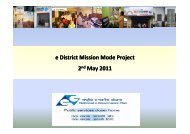State Mission Mode Project e-district - Department of Electronics and ...
State Mission Mode Project e-district - Department of Electronics and ...
State Mission Mode Project e-district - Department of Electronics and ...
You also want an ePaper? Increase the reach of your titles
YUMPU automatically turns print PDFs into web optimized ePapers that Google loves.
Study Report on Assessment <strong>of</strong> the <strong>Mode</strong>l e-<strong>district</strong>s<br />
• L<strong>and</strong> acquisition procedure<br />
• L<strong>and</strong> relinquishment procedure<br />
• L<strong>and</strong> exchange procedure<br />
In addition, following components <strong>of</strong> monitoring the collections from l<strong>and</strong> revenue also has been<br />
computerized Conduct <strong>of</strong> annual audit <strong>of</strong> village accounts (Jamabanthi) including collection <strong>of</strong><br />
current <strong>and</strong> arrears <strong>and</strong> preparation <strong>of</strong> Dem<strong>and</strong> Collection Balance register, which includes<br />
Administration <strong>of</strong> all types <strong>of</strong> revenue / loan collection<br />
A unique feature was built-in the TAS system, which was introduction <strong>of</strong> concept <strong>of</strong> unique<br />
transaction number, which meant, generation <strong>of</strong> automatic stamp <strong>of</strong> unique encoded number for<br />
each transaction. This has lead to two advantages:<br />
This enables to track down the identity <strong>of</strong> the data entry <strong>and</strong> approving authority, while identifying<br />
the exact transaction itself<br />
At any time one can identify the orders issued, by giving the unique number that was printed in the<br />
order copy<br />
Module 2: Issue <strong>of</strong> certificates/cards<br />
The Collectorate supported by the Taluk <strong>of</strong>fices are responsible for issuance <strong>of</strong> certificates through<br />
the e-<strong>district</strong> application as detailed below:<br />
• Administration <strong>of</strong> birth <strong>and</strong> death records including issuance <strong>of</strong> birth <strong>and</strong> death certificates<br />
• Issue <strong>of</strong> community certificates such as income / solvency / nativity certificates<br />
Module 3: Effective Citizen Grievance redressal system<br />
The entire grievance redressal mechanism was made online in the year 1999. This system enables<br />
the capturing <strong>of</strong> the petition details online <strong>and</strong> monitoring the disposal <strong>of</strong> petitions by various<br />
Government <strong>Department</strong>s online. It was one <strong>of</strong> the most successful initiatives under the e-<strong>district</strong><br />
implementation. It had a efficient backend operational process with e-<strong>district</strong> system functionality.<br />
The stepwise procedure for the Grievance redressal is mentioned below<br />
Step1: Petitions were received from the citizens <strong>and</strong> the system provides an acknowledgment to<br />
the petitioner as soon as the petition is given. The acknowledgement contains details like:<br />
• Serial number <strong>of</strong> the petition for tracking purpose<br />
• <strong>Department</strong> name<br />
• Subject <strong>of</strong> the petition<br />
• Date within which action has to be taken<br />
Step2: The <strong>district</strong> collector every week calls all the departments <strong>and</strong> the grievances <strong>and</strong> h<strong>and</strong>ed<br />
over to the various departments with timelines for redressal. Service levels are defined for each<br />
department.<br />
54




